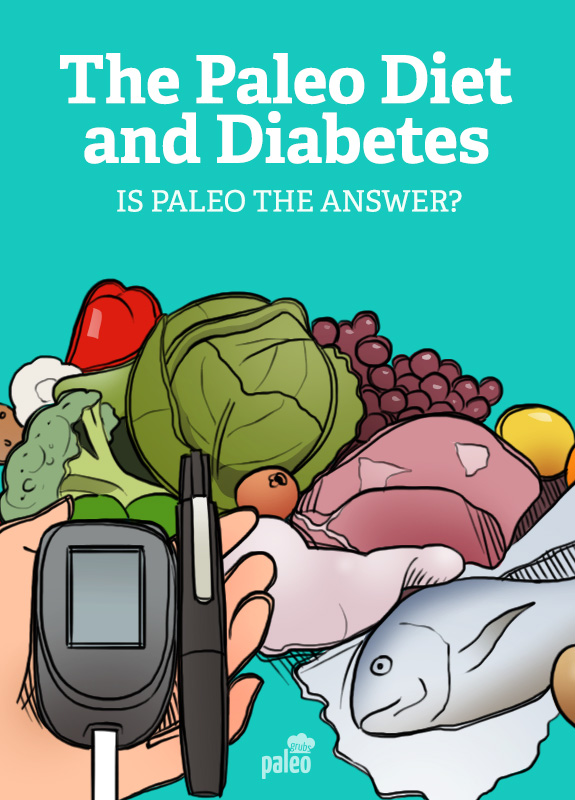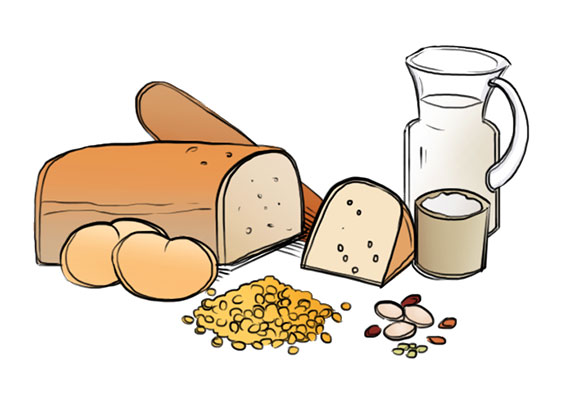Given the skyrocketing popularity of the Paleo diet in the last few years, proponents of the lifestyle have been touting it as a way to improve one’s health and reduce risk factors associated with chronic health conditions.
Many scholars, scientists, and health professionals are wondering if the diet of our cavemen ancestors could be a helpful solution to one of our biggest health problems, diabetes.
Let’s dive into the basics about diabetes first, and then take a closer look at how the Paleo diet may of benefit to those looking to manage the condition through dietary modifications.
Diabetes 101
Diabetes is the seventh leading cause of death in the United States, causing a number of serious health complications when left untreated or poorly managed.
According to the Centers for Disease Control and Prevention (CDC), in the year 2014, 29.1 million people, roughly 9.3% of the population, were living with diabetes.

There are two types of diabetes:
- Type 1 diabetes is usually diagnosed in children and young adults. Previously known as juvenile diabetes, only 5% of those diagnosed with diabetes have this form of the disease. In type 1 diabetes, the body does not produce insulin, and one must supply the body with insulin instead as a prescription medication.
- Type 2 diabetes is the most common form of the disease, and occurs when your body is unable to use insulin properly. This condition is often called insulin resistance. When insulin resistance first sets in, your pancreas can product extra insulin to make up for the condition, but over time, your pancreas cannot keep up with the amount of insulin required to stabilize your blood sugar levels, keeping them in the normal range.
It is important to note that Type 1 diabetes is technically anautoimmune condition as the pancreatic beta cells that produce insulin in the body are destroyed by an autoimmune attack.
In addition, Type 2 diabetes does not always require medication as an adjunct to treatment; however, in Type 1 diabetes, insulin must be supplied to the body daily through a prescription.
Lab Values and Blood Tests
If an individual isexperiencing any of the unusual symptoms listed below, medical testing for diabetes may be ordered:
- Severely increased thirst
- Frequent urination
- Unexplained weight loss
- Increased hunger
- Tingling of the hands or feet
In order to confirm the diagnosis of Type 2 diabetes, a test known as a fastingplasma glucose test (i.e. casual plasma glucose) will be ordered. According to the American Diabetes Association, the fasting plasma glucose test (i.e. FPG) is the preferred method for diagnosing diabetes due to its ease, convenience, and minimal cost.
Fasting blood glucose or blood sugar levels will range from 70 to 100 milligrams per deciliter or mg/dL in “normal” individuals. When two separate bloodtests reveal that a fasting blood glucose level is greater than or equal to 126 mg/dL, the diagnosis of diabetes can be confirmed.
However, there are instances in which a normal fasting blood sugar will require a glucose tolerance test, particularly if an individual has risk factors or symptoms associated with diabetes. If the glucose tolerance test reveals a rapid rise in blood sugar upon consumption of glucose, a diagnosis ofimpaired glucose intolerance is made, and testing should be repeated at regular intervals to continue to monitor for the development of diabetes.
Besides regular monitoring of blood glucose levels in the diabetic population, a test measuring one’s hemoglobin A1c (i.e. HgbA1c) is often conducted. Hemoglobin, the oxygen-carrying protein in red blood cells, and gives an approximate measure of how many sugar molecules are stuck to the hemoglobin (i.e. glycosylation).
HgbA1cis used a standard measure of blood glucose control, or lack thereof, over the three months preceding testing. It’s also used for diagnosis of diabetes and pre-diabetes, and often combined with fasting blood glucose testing to allow for a more accurate diagnosis. If an individual tests at a level between 5.7 and 6.4%, it is suggestive of pre-diabetes, whereas a level of 6.5% or higher indicates diabetes.
For more information on blood glucose monitoring, particularly in response to non-fasting ranges or postprandial ranges, click this link.
Diabetes and Diet
Diabetes is often referred to as a “lifestyle disease” meaning that it’s caused by factors within a person’s control such as diet and exercise, though it can have a genetic component. While additional risk factors such as obesity, lack of intentional exercise, and smoking are precursors for the Type II diabetes, dietary factors also appear to play a significant role.
A healthy diet is critical to the proper management of diabetes. Upon diagnosis, you have to start learning quite a bit about food and nutrition because of its affect on your blood sugar.
Whether or not you choose to follow a Paleo diet, you have to know about carbohydrates. Why are carbohydrates so important to understand as part of blood glucose control? Among all of the macronutrients, carbohydrates (i.e. starches and sugars) have the largest effect on your blood sugar.
Carbohydrates do not need to beavoided as part of a diabetic diet, though you may be able to better manage your condition through a reduced carbohydrate diet, which is why a Paleo approach may be so beneficial. For the most part, following a Paleo diet virtually eliminates refined sugars and grains, or the foods that spike your blood sugar the most, meaning it can be a very effective way to help stabilize your blood sugar.
“Since type 2 diabetes is characterized by elevated blood sugar levels caused by impaired insulin sensitivity, eventually accompanied by insufficient pancreatic insulin production, it seems intuitive that controlling dietary carbohydrates, the main nutrient that directly influences glycemia, would be a logical dietary approach for diabetes management.”
The American Diabetic Association actually supports the use of a low-carbohydrate diet in individuals diagnosed with type 2 diabetes, particularly if these individuals are overweight or obese and can benefit from weight loss; however, according to the organization, it cautions following this approach for more than one year, studies supporting the long-term safety of this approach have been somewhat sparse. (1)
On the other hand, researchers out of Sweden followed 16 obese subjects living with type 2 diabetes, and tracked their health as they maintained a low carbohydrate diet ( i.e. 80 to 90 g/day) over the course of 44 months. (2) After the initial six months of the study, data indicated that following a high-fat, low-carbohydrate diet for allowed the subjects to keep their HbA1c in check. After 44 months on this type of diet, their HbA1c dropped from 8% (i.e. baseline) to 6.8%, which is a desirable drop.
There’s no consensus on the definition of a low-carb diet in terms of how many carbohydrates are required to properly stabilize blood sugar, preventing it from dropping to low or staying too high. The main objective of all dietary intervention, however, should be to focus on increasing the consumption of nutrient-dense foods to ensure nutritional adequacy, and a Paleo diet is certainly capable of helping to do that.
The Term “Paleo” and General Recommendations
The concept behind the Paleo diet is based upon the belief that your optimal health is dependent upon adherence to somewhat specific dietary and lifestyle factors, factors which require very little genetic adaptation.
Those who support the Paleo diet believe that one’s genetic make-up is overwhelmingly reflect of the Paleolithiceraof human cultural development. The Paleolithic era, also known as the Stone age, began roughly 750,000 to 2.5 million years ago and came to an around 10,000 years ago.
Paleolithic type diets (i.e. Paleo), as you may already know, mimic the dietary patterns followed by our ancestors living during the pre-agricultural era. Also known as the hunter-gatherer era, our ancestors followed a diet composed of high levels of lean animal-source protein and uncultivated plant-source foods (i.e. fruits, vegetables, and nuts). Their diet was free from legumes or grains and was naturally lower in salt.
There are a number of version of the Paleo diet, thus it isn’t set in stone; however, in general it incorporates the following foods:
- Nuts
- Vegetables (preferably organic and fresh)
- Fruits (preferably “less sweet” fruits and organic)
- Fish
- Meat
- Poultry
In addition, most version of the Paleo diet exclude:
- Grains
- Dairy
- Legumes
- Sugars (other than fruit or honey(
- “Industrial” seed oils (i.e. soybean and corn)
- Modern processed, highly refined foods
Paleo’s Potential in Diabetes Management
The modernized version of the Paleo diet began gathering attention around 2008. Along with its growing popularity, individuals living diabetes have started to question if following a Paleo-based lifestyle is a healthy alternative to more commonly supported or standardized “diabetes diets.”
The simplest answer to that general inquiry is that there is still a lot of scientific evidence and research need to firmly say “yes,” but research continues to mount supporting its benefits in those battling with poor blood sugar control, either on the verge of being diagnosed with diabetes or already living with the disease.
Advocates of the Paleo diet believe that the human race hasn’t evolved efficiently from a metabolic sense to be able to adapt to changes in the standard Western diet as a result of recent agricultural developments. From a biochemical standpoint, the body has no way to thrive on the more recently developed processed creations that fund the food industry.
According to the Paleo diet’s biggest supporters, instead the Western diet has cause the population as a whole to suffer from chronic diseases associated with the modern world, in particular diabetes, which is now epidemic.
Why? According to Loren Cordain, the basic Paleonutritional guidelines are more in line with the evolutionary pressures that helped to shape our current genome. In turn, when you steer away from the Western diet and veer towards the Paleolithic approach, you are able to positively influence your health and well being, as in the case of diabetes and other chronic disease states.
“If you were to try to feed shrubs to a lion or meat to a cow, both would suffer nutritional deficiencies, illness and disease because of evolutionary discordance between their genome and the newly introduced environmental selective pressures,” says Cordain. “In a similar manner, newly introduced foods during the Neolithic, Industrial and modern eras are discordant with our species’ ancient and conservative genome, and can also result in illness and disease.”
Statements such as Cordain’s have sparked interest in the scientific world, and researchers in support of the Paleo diet are building their case around the benefits of going back to our prehistoric roots in an effort to improve overall health.
Four Impressive Scientific Studies
In 2013, the Paleo diet was among the world’s most popular diets; however, it is a rather controversial approach to managing diabetes among health professionals and mainstream nutrition organizations.
Although some medical professionals and health experts have embraced the diet as a healthy and reasonable dietary plan, other feel it can cause more harm than good. Given the debate, it might be helpful to turn to science for some answers, specifically answers to big questions such as the potential to reverse the diagnosis of diabetes.
“But what if type 2 diabetes could be completely reversed? What if it wasn’t, as we believe, an inexorable, progressive disease that has to be better “managed” by our health care system with better drugs, surgery and coordination of care? What if intensive lifestyle and dietary changes could completely reverse diabetes?”
1.One 2011 study conducted out of the University of San Francisco (UCSF) found that the Paleo diet led to a number of health improvements in subjects living with type 2 diabetes after only 2 weeks. (3) Though only a short time frame, the individuals followed as part of the study were able to improve their blood pressure, regulate blood sugar levels, and reduce cholesterol significantly.
It is important to note that other study participants placed on a traditional diet formulated by American Diabetes Association saw little to no improvement.
Calorie levels were tightly controlled to prevent all subjects from losing weight to eliminate the possibility of contributing health improvements to weight loss rather than dietary methods. As a side note, keep in mind that the subjects placed on a Paleo diet who were able to reduce their cholesterol levels incorporated proteins from lean sources such as chicken and fish rather than red meat or higher saturated fat protein sources.
2. Metabolic diseases, including type 2 diabetes, can quite frequently be effectively treated by improving thequality of one’sdiet. Researchers out of Sweden set out to determine if the glycemic load of the Paleo diet could help to control hunger while improving compliance, ultimately leading to better blood sugar control. (4) This is particularly interesting as no “diet” can be considered a lifestyle change if it is viewed as a temporary and fleeting change to nutrition habits.
The design of the studywas one in a traditional diet recommendation could be compared with Paleo diet recommendation for patients among subjects already diagnosed with diabetes. The main difference between the two dietary plans involves the inclusion of grains and dairy in the more traditional diabetes diet. In addition, the Paleo contributed approximately5% more protein in terms of a calorie contribution breakdown, while thetraditional diabetes diet was slightly higher in fiber.
Subjects were asked to use a questionnaire to indicate their satiety levels at the start and conclusion of each meal, using a scale of “very hungry” to “very full.” For a less subjective point of comparison, all food was weighed and measured. Without a significant report of increased satiety on the Paleo diet compared to the traditional diabetes diet,the subjects following the Paleo diet ate fewer calories per meal on average, reported more weight loss, and experienced better blood sugar control.
Interestingly enough, a significant number of the Paleo dieters reported some difficulty with adherence, feeling it was bland, monotonous, and expensive. While this may be true for those just starting out on the Paleo diet, the internet is now buzzing with loads of tasty Paleo-friendly recipes, and there are some definite cost-saving measures one could take.
If the ultimate goal is to manage diabetes and improve health, adherence could most likely be increased with some additional Paleo education.
3. In one small 2009 study, spanning three months, researchers designed a study with the goal of comparingthe effects of a Paleo diet and a diabetes diet on risk factors for cardiovascular disease; however, the subject group was comprised of subjects diagnosed with type 2 diabetes, not being treated with insulin. (5)
A total of 13 individuals, 3 women and 10 men, were instructed to follow a Paleo diet, specifically incorporating lean meat, fish, fruits, vegetables, root vegetables, eggs and nuts. In comparison, the diabetes diet was designed in accordance with the standard dietary guidelines. Food diaries were used to help assess the dietary choices contributing to the energy density and glycemic load throughout the study.
The outcome measures included things such as weight changes, waist circumference, serum lipids, C-reactive protein, blood pressure; however, with respect to diabetes specifically, HbA1c was tracked as well.
Data analysis lead researchers to conclude that the Paleolithic diet led to improvements in glycemic control and lower A1c levels as compared to a diabetes diet. There were other significant differences as well, per the following summary:
“The The Paleolithic diet used was lower in cereals and dairy products, and higher in fruits, vegetables, meat and eggs. It was also higher in unsaturated fatty acids, dietary cholesterol and several vitamins. It was lower in total energy, energy density, carbohydrate, dietary glycemic load (GL) and glycemic index (GI), saturated fatty acids and calcium.”
4. Another 12-week randomized controlled study, tracking 29 men living with ischemic heart disease and impaired glucose tolerance or type 2 diabetes, concluded that a Paleo diet improved glucose tolerance, independent of weight-loss, when compared against a version of the Mediterranean diet. (6)
The subjects were randomized to follow either a Paleo or a Mediterranean diet, and neither group was calorie restricted. The main outcomes tracked as part of the 12 week study included glucose tolerance, insulin levels, weight and waist circumference.
At the end of 12 weeks, only the Paleo diet group experienced significant improvements in glucose tolerance, though both groups were able to lose weight as part of the study. Interestingly enough, the Paleo grouphad a 5.6 cm or 2.2 inch reduction in waist circumference, while the Mediterranean diet group had a 2.9 cm or 1.1 inch waist circumference decrease.
Not only did the Paleo diet group experience improvements in glucose tolerance, but every subject (i.e. 14 subjects) assigned to the Paleo group ended up having normal blood sugars, compared to 7 out of 15 subjects in the comparison group.
This finding is particularly important in considering how a Paleo diet may improve glucose control. Impaired glucose tolerance (i.e. dysglycemia), which is often present in the pre-diabetic state, is associated with insulin resistance. Remember, insulin resistance is a significant precursor to the development of diabetes.
Take Home Message
Considering the skyrocketing popularity of the Paleo diet within recent years, proponents of this lifestyle have been touting it as a way to improve one’s health, particularly with respect to diabetes.
A growing body of research is strengthening the idea that high quality, real foods can help to prevent and reverse Type 2 diabetes. In addition, many scholars, scientists, and health professionals are wondering, and thus investigating, if the diet of our cavemen ancestors is a reasonable, safe, and healthy approach to managing the condition of diabetes after diagnosis.
As support of the Paleo diet grows as a way to help regulate blood sugar, there is still no standardized diet or definition of just how many carbohydrates are required to properly stabilize blood glucose levels, preventing it from dropping to low or staying too high. Instead, the main objective of all dietary intervention, should be to focus on increasing the consumption of nutrient-dense foods to ensure nutritional adequacy, and a Paleo diet is certainly capable of helping to do that.
After reviewing research, it appears that at least a short-term dietary pattern following Paleo guidelines, can lead to favorable improvements in diabetes. Because this diet excludes so many of the highly processed and nutritionally poorqualityfoods found in that of a typical Western diet, it only makes sense that health improvements can result.
On the other hand, it is too early to say that a Paleo diet should be the one and only approach that every individual living with diabetes should follow as there are going to be exceptions to every rule. Perhaps as long-term studies on Paleo’s role in diabetes management builds, this will change.
It is clear from looking at more recent studies that the Paleo diet does lead to improvements in insulin sensitivity and glycemic control, which could be correlated to its reduced carbohydrate and glycemic load.
Ifyou suspect you have diabetes or pre-diabetes, you may choose to consult a knowledgeable health practitioner prior to making significant changes to your current dietary patterns.
If you have already been diagnosed with diabetes and feel like Paleo is the way to go for you, be sure to consult with a Registered Dietitian and medical professional to ensure that you transition into this dietary plan in a safe and reasonable manner, particularly if you are taking prescription medication.
Paleo Diet and Diabetes (Is Paleo the Answer?)
Stacey (RD, CHFS, Certified Integrative Health Coach)







0 Comments